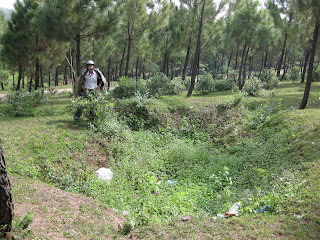


When I used to hunt for thrift-store vinyl (whole LPs were going for about 25 cents each in the late 90's), I always looked for albums which made a strong stand for some clear aesthetic, but without any (effective) irony. This resulted in a record collection replete with cowboy and Christian music, with a distinct peak somewhere in the early sixties, where a certain kind or lack of self-consciousness reigned, that strikes the post-modern mind as nakedly psychotic.
This was what our tour guide reminded me of. We had reached My Son by private buses, en mass, about 150 tourists; and I am fairly certain that his shrillness was an adaptation to the sheer crowd size who arrived now to see the ruins of one of the great temple complexes of the Cham people. An adaptation by way of Viet Cong drill sergeant, with the guttural intensity of a samurai, attacking us with facts, leaping about and hacking the aair with an intensity that recalled Bruce Lee at his best, when he had made his martial art, Jeet Kwan Do, JKD, into a lifestyle, a momennt-to-moment philosophy, quick-footed and adaptable, unphased by the presence of powerful adversaries.
And so he bristled with energy as he gesticulated and adressed us in Tour Guide Vox Yakuza, bringing a high-school basket ball coach intensity to Cham factoids. He betrayed his military background by referring to our visit as an "exercise".From what he shouted I gathered that the Cham were a people of Javan descent, who ruled a sizeable chunk of the center part of modern Vietnam for almost a thousand years, beating back the in turn the Han, Viet, and Khmer empires while worshipping a muscular and fertile Hindu-inspired pantheon, their lust for life still bursting through the eroded stone.
Inside each temple with its tiered, stone animal and green plant-bedecked roof, was a table-like altar with a holes in the centers, the building's yoni, which our guide joked was realistic-looking but he could not say for himself due to being single. Outside were several ceremonial stone lingams which would be carried into the temples and inserted into the yonis to bring the various gods and spirits into union, perhaps to re-start the cycle of fertility. Not surprisingly, our guide made a big show of getting women in the group to touch one of these hefty divine dildos.












